The success in the Sinai was largely due to the combination of courageous men and their sturdy horses. The 1st, 2nd, and 3rd Australian Light Horse Brigades, together with the New Zealand Mounted Rifles Brigade, served in the Middle Eastern campaign. The Australians were called Light Horsemen, while the New Zealanders were commonly known as ‘the mounteds’. The soldiers of both nations were armed and equipped in a similar way.
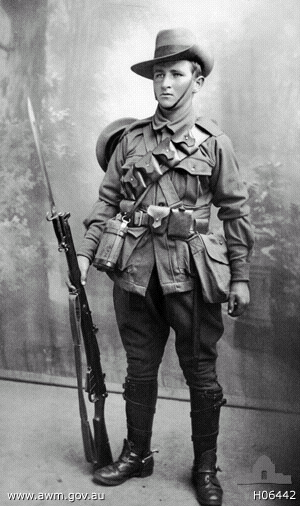 The Australian Light Horse was formed during the time of the Boer War as a mounted infantry reserve army of volunteers. At the time of the outbreak of World War 1, there were 23 regiments around the nation consisting of about 9,000 men. Many of these then enlisted into the army. Most were from the countryside where horses were the main mode of transport and the men were familiar with horses and shooting. Unlike cavalry, that were trained to fight from horseback and equipped with long swords, the Light Horse men were trained to dismount and go into combat on foot equipped with shorter bayonets, a rifle and a bandolier carrying 90 rounds of ammunition. The normal pattern for the Light Horse was to ride in sections of four near to the battle front, where one man would look after all the horses, staying close enough to escape or advance as needed, while the other three went into action.
The Australian Light Horse was formed during the time of the Boer War as a mounted infantry reserve army of volunteers. At the time of the outbreak of World War 1, there were 23 regiments around the nation consisting of about 9,000 men. Many of these then enlisted into the army. Most were from the countryside where horses were the main mode of transport and the men were familiar with horses and shooting. Unlike cavalry, that were trained to fight from horseback and equipped with long swords, the Light Horse men were trained to dismount and go into combat on foot equipped with shorter bayonets, a rifle and a bandolier carrying 90 rounds of ammunition. The normal pattern for the Light Horse was to ride in sections of four near to the battle front, where one man would look after all the horses, staying close enough to escape or advance as needed, while the other three went into action.
The horse carried their supplies: a haversack which contained their food, eating utensils, a change of underpants, soap, a pocket knife, and bandages. They also had a one litre water container, a ground sheet and blanket, extra ammunition and a hat. In addition, there were the essentials for the horse, such as water bucket, nose bag and feed, heel rope, hobble chains, neck rope, horseshoes and nails. Add to that the saddle, stirrups and bridle and the total load could be 130-150 kg! 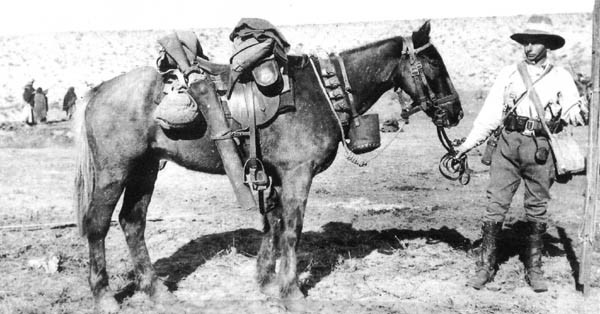 Then there was the rider in his full uniform, including boots. In the Sinai, they had to carry this in 50 degree plus temperatures by day and cold nights, through sand, and often at a gallop. Furthermore, they sometimes had to endure 60-70 hours without water and had annoying flies, ticks, fleas and scorpions to contend with. Twelve thousand horses produce an estimated 113,400 kg of manure per day attracting millions of flies. This is not to mention the Camel Corps and the mules that were also used.
Then there was the rider in his full uniform, including boots. In the Sinai, they had to carry this in 50 degree plus temperatures by day and cold nights, through sand, and often at a gallop. Furthermore, they sometimes had to endure 60-70 hours without water and had annoying flies, ticks, fleas and scorpions to contend with. Twelve thousand horses produce an estimated 113,400 kg of manure per day attracting millions of flies. This is not to mention the Camel Corps and the mules that were also used.
Walers carried up to 150 kg of luggage plus the rider in 50 degree temperatures over sand, sometimes for three days without water.
Before they could enlist in the Light Horse, the men had to be 18 years old, and pass a medical test and a riding test. They were then given military training. Many faked their age and enlisted far younger. A blind eye was mostly turned to this, especially if they were good horsemen. If the recruit came with a horse, he was most likely able to keep it, but it was purchased by the government and became army property. A great bond developed between man and horse and the lives of each often depended on the other.
The Slouch Hat
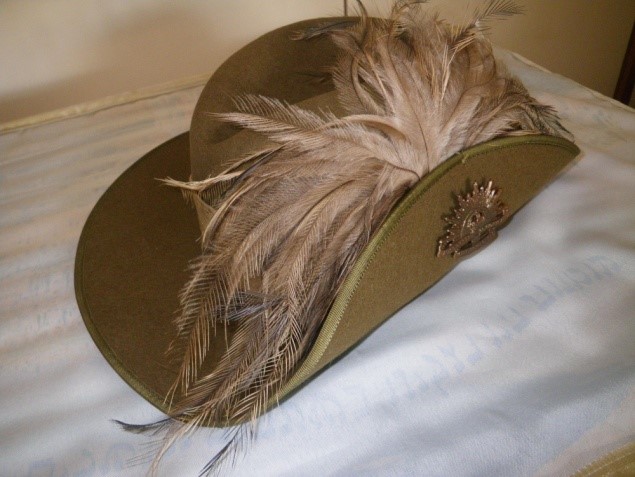 The most distinctive part of the Light Horse uniform was the slouch hat with the emu feathers. The khaki hat was first used in the military by the Victorian Mounted Rifles in 1885 and by 1890 it was widely adopted and worn in the Boer War. With the formation of a national army in 1903, the slouch hat, turned up on the left side became part of the uniform. Different units added different bird feathers. In the 1st World War, the rising sun badge was also in use on the hat. The emu plumes were first given to the Queensland Mounted infantry as a reward for service after the shearers’ strike of 1891. Some World War 1 Queensland units and the 3rd brigade headed for the Middle East wearing the emu feathers. When they arrived in Egypt it caused a stir until it was decided that all units could adopt it. It became the trademark of the Light Horsemen in the Middle East and became a national symbol of the bravery and sacrifice of the World War 1 soldiers. The Arabs called the Australians the ‘King of the Feathers’,
The most distinctive part of the Light Horse uniform was the slouch hat with the emu feathers. The khaki hat was first used in the military by the Victorian Mounted Rifles in 1885 and by 1890 it was widely adopted and worn in the Boer War. With the formation of a national army in 1903, the slouch hat, turned up on the left side became part of the uniform. Different units added different bird feathers. In the 1st World War, the rising sun badge was also in use on the hat. The emu plumes were first given to the Queensland Mounted infantry as a reward for service after the shearers’ strike of 1891. Some World War 1 Queensland units and the 3rd brigade headed for the Middle East wearing the emu feathers. When they arrived in Egypt it caused a stir until it was decided that all units could adopt it. It became the trademark of the Light Horsemen in the Middle East and became a national symbol of the bravery and sacrifice of the World War 1 soldiers. The Arabs called the Australians the ‘King of the Feathers’, 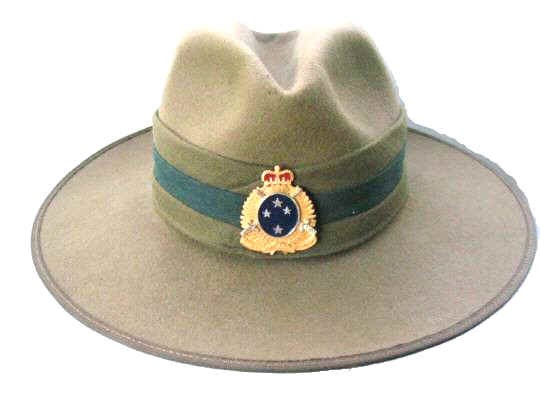 and the Aussies jokingly told the locals they were ‘Kangaroo Feathers’! The turned-up brim was functional as it did not get in the way of the rifle slung over the shoulder. I have been told that the emu feather was originally a reward for those who could run fast enough to catch an emu and grab a feather. The New Zealanders wore a flat, broad-brimmed hat.
and the Aussies jokingly told the locals they were ‘Kangaroo Feathers’! The turned-up brim was functional as it did not get in the way of the rifle slung over the shoulder. I have been told that the emu feather was originally a reward for those who could run fast enough to catch an emu and grab a feather. The New Zealanders wore a flat, broad-brimmed hat.
It should be noted that amongst the Allied and ANZAC troops were many other nationalities. There were soldiers of Chinese, Malaysian, Hong Kong and Singaporean origin. Especially in the latter part of the Middle Eastern campaign Indians played a vital part. 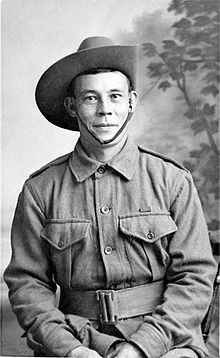 The Allied troops also had recruits from the West Indies. Britain was recruiting from all her colonies to replace the thousands who were being killed and injured on the battle field. They fought side by side and often died side by side also.
The Allied troops also had recruits from the West Indies. Britain was recruiting from all her colonies to replace the thousands who were being killed and injured on the battle field. They fought side by side and often died side by side also.
Billy Sing was born in Clermont, Queensland to an English mother and Chinese father and served in Gallipoli and France. He was part of the 5th Light Horse Regiment and was an acclaimed sniper. He won a Distinguished Conduct Medal for his ability.
Aboriginal Light Horsemen
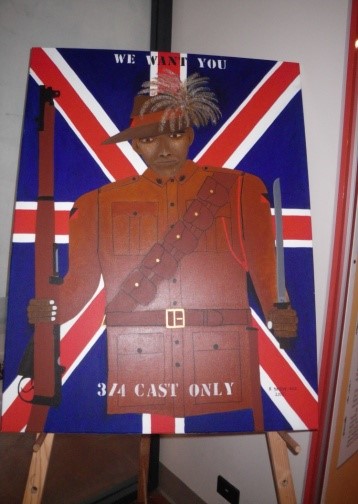 Initially, Aboriginals were rejected as recruits because they were not ‘white’ enough. Consequently, some pretended to be of another ethnicity in order to enlist. By October 1917, with much loss of life, replacement recruits became harder to find and the requirements began to be slackened. According to the Australian War Memorial, over 1,000 indigenous men served in World War 11 and received equal rights while in the army. However, after the war ended, despite their service, they were not given the benefits that were granted to other ex-servicemen. Most of the indigenous volunteers came from Queensland where some 500 men enlisted, but only 118 of these served overseas – about 20%. One whole group of reinforcements, known as the ‘Queensland Black Watch’, was almost entirely indigenous. They joined the 11th Light Horse Regiment.
Initially, Aboriginals were rejected as recruits because they were not ‘white’ enough. Consequently, some pretended to be of another ethnicity in order to enlist. By October 1917, with much loss of life, replacement recruits became harder to find and the requirements began to be slackened. According to the Australian War Memorial, over 1,000 indigenous men served in World War 11 and received equal rights while in the army. However, after the war ended, despite their service, they were not given the benefits that were granted to other ex-servicemen. Most of the indigenous volunteers came from Queensland where some 500 men enlisted, but only 118 of these served overseas – about 20%. One whole group of reinforcements, known as the ‘Queensland Black Watch’, was almost entirely indigenous. They joined the 11th Light Horse Regiment.
Endnotes:
Pictures:
- Trooper Stephen Arbuthnot – 8th Light Horse, Killed at Gallipoli https://www.awm.gov.au/collection/H06442/
- Taffy & Cpl Edwards – Light Horse WW1 http://www.lighthorseart.com.au/Taffy-Waits/ 3. Light Horse Hat – Jill Curry
- New Zealand Mounted Rifles hat - http://www.diggerhistory.info/pages-uniforms/slouch_hat_+.htm
- Billy Sing – DCM, 5th Light Horse Regiment. Australian War Memorial https://www.awm.gov.au/collection/P03633.006 Gale's Studios Ltd, UK.
- Painting by indigenous artist R. Syron, Townsville Cultural Centre – Jill Curry. Unsuccessful attempts have been made to contact the artist.

